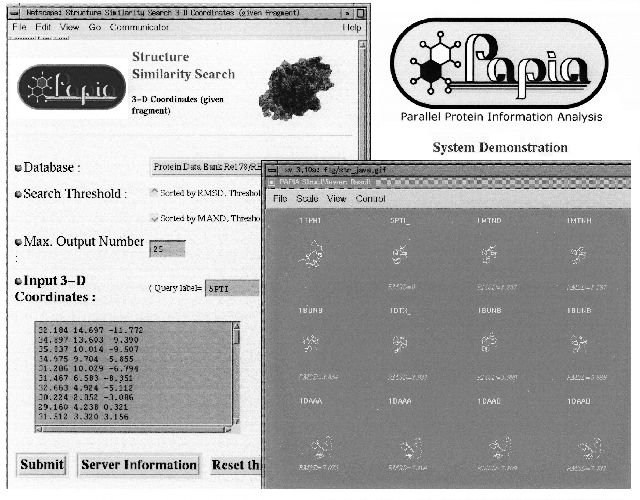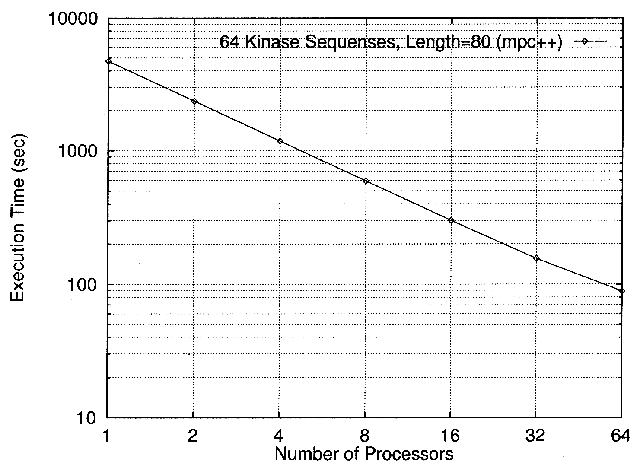
Fig.1:Protein Structure Similarity Search on PAPIA

Fig.2: Executiom Time for Mutiple
Sequense Alignment on PAPIA
At SC'97 in November 1997, we successfully demonstrated the high performance and practical suitability of PC Cluster used in applications for protein research. The demonstration was performed on the RWC PC Cluster II.
We have developed a system which encompasses both typical computing and database search required for analysis of protein structure and sequence information. This system is called ³PArallel Protein Information Analysis system,² or ³PAPIA system,² in short. The demonstration at SCı97 was quite successful, attracting large audience. In spite of many difficulties encountered along the way to completion, the project proved to be impressive and rewarding. It was the capstone of much effort exerted by members at the Tsukuba Research Center.
As for the RWC PC Cluster II shown at SCı97, it consists of 64 Pentium Pro (200 MHz) processors. Each node has 256-MB memory and a 2.1-GB hard disk. This configuration is suitable for parallel database search and its superb inter-communication capability is powerful in parallel computing as well. When invited by Dr. Yutaka Ishikawa, Chief of the System Software Group in charge of developing the PC Cluster II, to demonstrate our application at SCı97, I am willing to participate.
In the process of preparation for SCı97, however, several difficulties had to be confronted and remedied. The motto of our laboratory is: ³to create applications not for just evaluation but for actual use,² for serious computational biology. The goal for short-time development and practibility needed to be attained at once: how the PC Cluster ought to be presented beneficially was thoroughly considered. Preparations were initiated in August 1997, but the PC Cluster II would not be completed until October, leaving only 1-2 weeks before export to be rendered for application. In due course, development and testing on another environment were completed; however, there was, obviously, no environment like the PC Cluster II, with a huge disk, memory capacity and system software. The final week prior to shipment was entirely spent on the lab floor, for completion of the application.
The System Software Group may have expected various different small types of applications to be shown in the demonstration of the time-sharing system for multi-users. We, on the other hand, intended to provide a single large and fast application PAPIA. This great gap in understanding at times became perplexing.
Although installation of the application in the process of completing the system as if aiming at a moving target proved rigorous, the demonstration was ready for SCı97, thanks to the unyielding passion, cooperation and endurance of the application developers, members of the Software Laboratory, and the superb development environment provided on the UNIX system.
As typical process examples required for the protein analysis, the following three issues were fulfilled in PAPIA:
1) Protein Structure Similarity Search
When a fragmental structure of protein is entered, similar partial structures are searched in known proteins. A great amount of computing of optimal superposition among 3-dimensional structures will occur.
The PDB database is searched in parallel. If similar structures are found, they are displayed in 3 dimensions on a JAVA screen together with information such as the distance between two structures (Fig. 1).
2) Protein Sequence Homology Search
When a protein sequence information is entered, known proteins with similar sequence (regardless of the structure) are precisely searched using the dynamic programming method. Again, the PDB database is searched in parallel.
3) Protein Multiple Sequence Alignment
This is an example of a high-speed execution of a purely computational problem with parallel processing, not database search. The sequence information differs quite a bit even in the same type of protein depending on species and internal organs which contain it.
The process is to align column positions which should have the same or similar letters in several ten or hundred sequences given.
Seemingly simple, this process is extremely difficult. To estimate how the ancestor sequence looks based upon descendant sequences with great alterations, provides quite a challenge. Also, since the number of cases to be tried had augmented, a vast amount of computing became necessary. Fig. 2 shows an example performance (with 64 Kinase enzyme sequences). It takes 79 minutes to compute on a single processor, but when all 64 PC Cluster processors are used, it takes only 89 seconds.
By examining alignment results displayed in various colors, important function motifs can be detected, as positions in protein sequences preserved through the history of evolution are shown in a same letter color.
These achieved three functions were designed not only for demonstration at SCı97, but for actual use. One feature of PAPIA is its quite high computing accuracy.
In the past, programs based on coarse approximation were commonly ran generally by a single PC for a single biologist, often causing overlooks or errors. Our group attempts to provide accurate real-time solutions with drastic improvement in speed through parallelization. If answers can be retrieved in affordable time, biologists prefer to use the most accurate techniques. PAPIA may help to rediscover missing clues.
The first feature of PAPIA is its high speed and accuracy, as described above. Secondly, ease of use through WWW characterizes the PAPIA. For demonstration at SCı97, job submission mechanism via WWW, queue system and browser-based result viewing in color were made available. Computing results are linked to related data on the Internet. Demonstration of the PAPIA System is planned for free service by late April 1998 (at the following URL). http://www.rwcp.or.jp/papia/


Fig.2: Executiom Time for Mutiple
Sequense Alignment on PAPIA